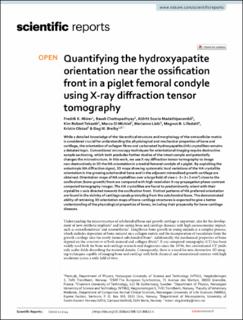| dc.contributor.author | Mürer, Fredrik Kristoffer | |
| dc.contributor.author | Chattopadhyay, Basab | |
| dc.contributor.author | Madathiparambil, Aldritt Scaria | |
| dc.contributor.author | Tekseth, Kim Robert Bjørk | |
| dc.contributor.author | Di Michel, Marco | |
| dc.contributor.author | Liebi, Marianne | |
| dc.contributor.author | Lilledahl, Magnus Borstad | |
| dc.contributor.author | Olstad, Kristin | |
| dc.contributor.author | Breiby, Dag Werner | |
| dc.date.accessioned | 2022-09-20T12:00:28Z | |
| dc.date.available | 2022-09-20T12:00:28Z | |
| dc.date.created | 2021-01-27T14:18:52Z | |
| dc.date.issued | 2021 | |
| dc.identifier.citation | Mürer, F. K., Chattopadhyay, B., Madathiparambil, A. S., Tekseth, K. R., Di Michiel, M., Liebi, M., Lilledahl, M. B., Olstad, K. & Breiby, D. W. (2021). Quantifying the hydroxyapatite orientation near the ossification front in a piglet femoral condyle using X-ray diffraction tensor tomography. Scientific Reports, 11, Artikkel 2144. | en_US |
| dc.identifier.issn | 2045-2322 | |
| dc.identifier.uri | https://hdl.handle.net/11250/3019139 | |
| dc.description.abstract | While a detailed knowledge of the hierarchical structure and morphology of the extracellular matrix is considered crucial for understanding the physiological and mechanical properties of bone and cartilage, the orientation of collagen fibres and carbonated hydroxyapatite (HA) crystallites remains a debated topic. Conventional microscopy techniques for orientational imaging require destructive sample sectioning, which both precludes further studies of the intact sample and potentially changes the microstructure. In this work, we use X-ray diffraction tensor tomography to image non-destructively in 3D the HA orientation in a medial femoral condyle of a piglet. By exploiting the anisotropic HA diffraction signal, 3D maps showing systematic local variations of the HA crystallite orientation in the growing subchondral bone and in the adjacent mineralized growth cartilage are obtained. Orientation maps of HA crystallites over a large field of view (~ 3 × 3 × 3 mm3) close to the ossification (bone-growth) front are compared with high-resolution X-ray propagation phase-contrast computed tomography images. The HA crystallites are found to predominantly orient with their crystallite c-axis directed towards the ossification front. Distinct patterns of HA preferred orientation are found in the vicinity of cartilage canals protruding from the subchondral bone. The demonstrated ability of retrieving 3D orientation maps of bone-cartilage structures is expected to give a better understanding of the physiological properties of bones, including their propensity for bone-cartilage diseases. | en_US |
| dc.language.iso | eng | en_US |
| dc.rights | Navngivelse 4.0 Internasjonal | * |
| dc.rights.uri | http://creativecommons.org/licenses/by/4.0/deed.no | * |
| dc.title | Quantifying the hydroxyapatite orientation near the ossification front in a piglet femoral condyle using X-ray diffraction tensor tomography | en_US |
| dc.type | Peer reviewed | en_US |
| dc.type | Journal article | en_US |
| dc.description.version | publishedVersion | en_US |
| dc.rights.holder | © The Author(s) 2021. | en_US |
| dc.source.pagenumber | 12 | en_US |
| dc.source.volume | 11 | en_US |
| dc.source.journal | Scientific Reports | en_US |
| dc.identifier.doi | https://doi.org/10.1038/s41598-020-80615-4 | |
| dc.identifier.cristin | 1880438 | |
| dc.relation.project | Norges forskningsråd: 262644 | en_US |
| dc.relation.project | Norges forskningsråd: 272248 | en_US |
| dc.relation.project | Norges forskningsråd: 275182 | en_US |
| dc.source.articlenumber | 2144 | en_US |
| cristin.ispublished | true | |
| cristin.fulltext | original | |
| cristin.qualitycode | 1 | |

